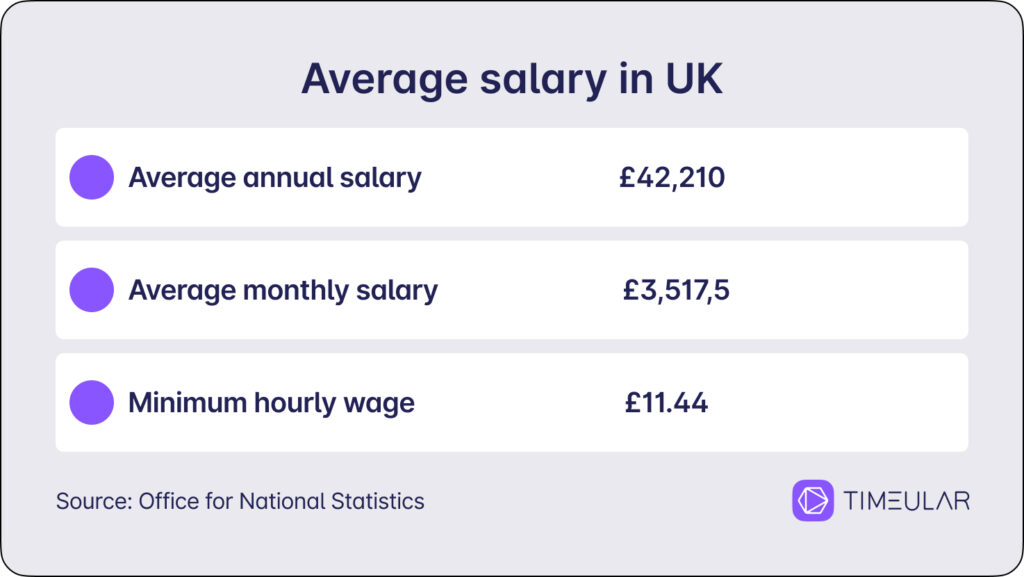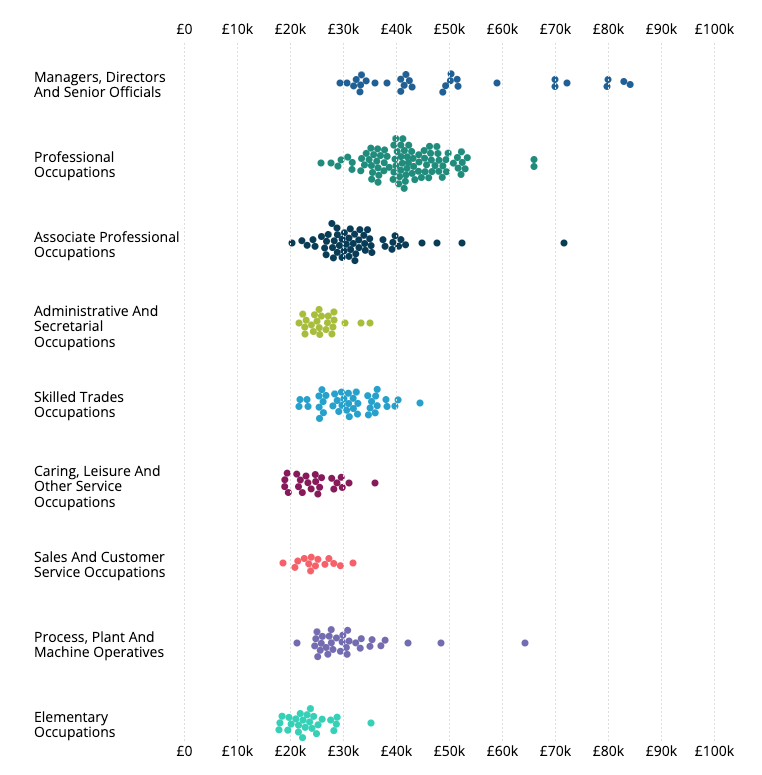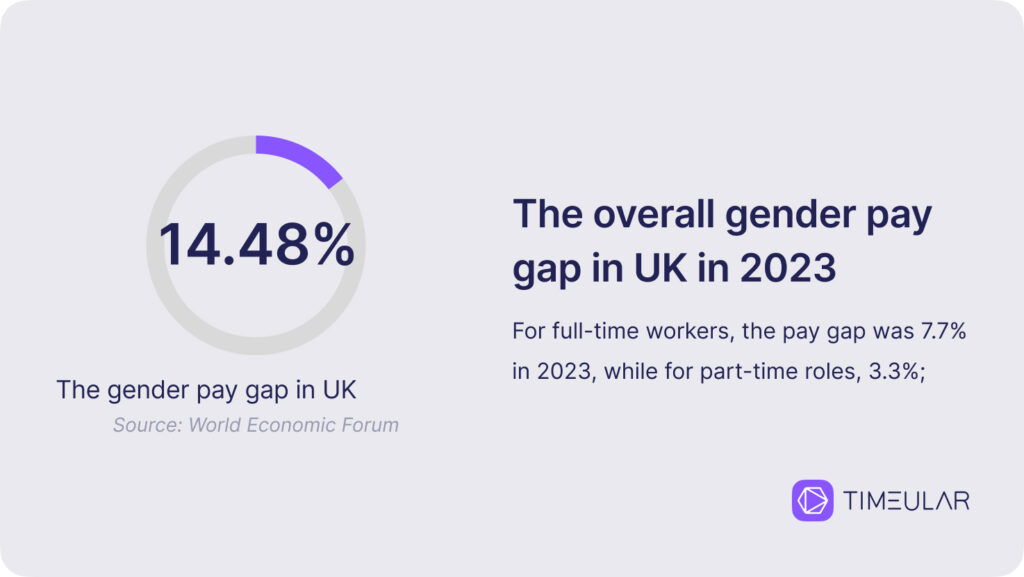Average salary in UK
According to the UK’s Office for National Statistics, the latest data on the UK average salaries shows that the annual pre-tax salary in 2023 was £42,210 for full-time workers.
In this article, I will break down how the average salary in the UK varies by region, city, education, occupation, or gender so you can get a full picture.

Key labor statistics
- Average annual salary: £42,210
- Average monthly salary: £3,517,5
- Median salary: Median weekly earnings in the UK are £682 (gross) for a full-time program, which is the equivalent of a £35,464 median gross annual pay. Part-time workers earn £241 per week.
- Minimum hourly wage: £11.44; £1830,4 monthly
- Gender pay gap: 14.48% in 2023
Note that in the UK, full-time workers are employees who work 30 hours per week or more.
Average Salary in the UK
In 2023, the average income in the UK for full-time employees was £42,210, while the average UK salary per month is £3,517,5, according to the Office for National Statistics. The average salary for a part-time schedule in 2023, according to the same source, was £15,212. Both average UK salaries increased by 5.4% in 2022, while the latter increased by 3.1% in the same year.
The salaries mentioned above are overall figures that differ from case to case depending on the region, industry sectors, age group, or gender.
Median salary in the UK
The median salary generally represents a more accurate picture of the earnings in the UK, as the median pay reflects the midpoint of salary distribution. In other words, the median pay breaks salary distribution into two parts, with half of the population earning above the midpoint and the other below the midpoint.
The median annual earnings was £34,963 in 2023 for full-time workers, higher by 5.8% compared with 2022, according to the Office for National Statistics. Regarding the median weekly earnings, the median weekly earnings in April 2023 were £682, with a 6.2% increase compared to the previous year, but this also represents the highest wage growth since 1997.
The median weekly earnings for full-time workers have seen growth across most major occupations, emphasizing lower-paying ones. Examples of these occupations are caring, leisure, sales, and customer service. Part-time earnings were situated at £241 in April 2023.
An interesting fact that we’ll cover in more depth in the gender gap section is that between 2022 and 2023, median weekly earnings increased by 9.1% for women, compared with a 6.8% increase for men.
Minimum wage
In the UK, the national minimum wage is the minimum amount per hour most employees are entitled to. The minimum wage is applicable based on someone’s age, and it differs based on age groups.
The National Living Wage is £11.44 in 2024.
According to the latest Government data, the minimum wages that apply are the following:
- For employees with the school leaving age, they receive the National Minimum Wage
- For employees aged 21 and over, they will receive the National Living Wage
The apprentices have access to the minimum wage age if they fulfill two conditions:
- They are aged 19 or over and
- They have already completed the first year of their apprenticeship
For example, an apprentice aged 21 with one year of apprenticeship is entitled to a minimum hourly rate of £11.44.
| 21 and over | 18 to 20 | Under 18 | Apprentice | |
| April 2024 | £11.44 | £8.60 | £6.40 | £6.40 |
Average salary in the UK by state
The average salary in the UK varies significantly by region, with England leading at £136,000, driven by high-paying industries in London and the Southeast. Scotland follows with an average salary of £99,900, reflecting a strong financial sector in cities like Edinburgh.
In contrast, Wales and Northern Ireland have lower average salaries, at £67,700 and £65,000, respectively, highlighting regional economic disparities across the UK.
| State | England | Northern Ireland | Scotland | Wales |
| Average Salary | 136,000 GBP | 65,000 GBP | 99,900 GBP | 67,700 GBP |
Average UK salary by city
According to the ONS, in April 2023, the median average weekly earnings in different local authorities are as follows. You’ll find the highest median pay per week in the table below.
- City of London: £1,120
- Tower Hamlets, London: £1,054
- Westminster, London: £906
- Inner London: £903
- Islington, London: £897.40
- Mole Valley: £878
- Hackney, London: £865
- Three Rivers, Hertfordshire: £863
- Shetland Islands, Scotland: £859
- Camden, London: £850
As expected, the highest average earnings are in the London area and other metropolitan areas.
Average salary by region
Location affects someone’s paycheck, and the UK is no exception to this rule. Here is the overview of average annual salaries in the UK, based on region:
| UK Region | Average Annual Salary |
| South East England | £31,800 |
| South West England | £28,748 |
| North West England | £28,429 |
| West Midlands | £28,352 |
| East Midlands | £27,782 |
| Yorkshire and The Humber | £27,648 |
| North East England | £26,959 |
Average salary by age
According to the ONS Annual Survey for Hours and Earnings (November 2023), age in the UK has a considerable weight on the average earnings. The higher the age, the higher the weekly earnings become until reaching the age of 50. From the age of 50, earnings start to lower again.
The same report done by ONS reveals the following data:
- Median weekly earnings in the UK are £682 (gross) for a full-time program, which is the equivalent of a £35,464 median annual salary. Part-time workers earn £241 per week.
- Young people under the age of 30 earn 25% less than employees over 40;
- Employees between 40 and 49 have the highest median annual earnings, namely £40,040, while the median weekly earnings are £770
| Age | Weekly Gross Wage | Annual Gross Salary |
| 18-21 | £441 | £22,932 |
| 22-29 | £583 | £30,316 |
| 30-39 | £722 | £37,544 |
| 40-49 | £770 | £40,040 |
| 50-59 | £727 | £37,804 |
| 60+ | £651 | £33,852 |
As seen above, employee earnings are highest throughout the 20s, 30s, and 40s, which are the timeframes in an employee’s life with career advancements, educational opportunities, or promotions.
Average salary by education
At times, education can impact salary and wage growth more than other factors, and in the UK, that is the case, too. Here are the weekly and gross annual salaries based on degrees:
| Degree | Weekly Wage (median average) | Gross Annual Salary |
| Degree or equivalent | £694 | £30,524 |
| A-levels or equivalent | £435 | £22,620 |
| GCSE grades A-C or equivalent | £381 | £19,812 |
| No qualification | £304 | £15,808 |
Average salary by occupation
When assessing the ONS Annual Salary Survey for Hours and Earnings from November 2023, the following are noticed:
- The very high earners in the UK are in managerial and professional occupations;
- Health professionals have the highest average salaries after managers, chief executives, directors, and other senior officials, followed by teaching professionals;
- The lowest weekly earnings are found in leisure and travel;
- Lower wages are also found in the cases of young employees with shorter work times or in elementary services, like food, cleaning, or deliveries.

Source: Annual Survey of Hours and Earnings from the Office for National Statistics
By breaking down the top highest salaries in the UK, according to ONS, the following median annual earnings are identified in full-time jobs:
- Chief executives: £84,131
- Marketing, sales, and advertising executives: £83,015
- IT directors: £80,000
- Public relations and communications directors: £79,886
- Logistics, warehousing, and transport directors: £72,177
- Pilots and air traffic controllers: £71,676
- Financial managers and directors: £70,000
- Functional managers and directors: £69,933
- Specialist medical practitioners: £66,031
- Headteachers and principals: £66,014
Gender pay gap
The overall findings about the UK’s pay gender gap are:
- The overall gender pay gap for 2023 was 14.48%, according to the World Economic Forum;
- For full-time workers, the pay gap was 7.7%;
- The part-time pay gap was 3.3%;
- Men earn more than women in full-time roles, regardless of their age and other factors;
Regarding trends, the gender pay gap in the UK has gradually decreased since 1997 for full-time workers; however, the part-time gender pay gap has remained small or even negative. Since 1997, the proportion of full-time working women has seen an increase from 36% to 41%.
According to the Labor Force Survey performed by the Office for National Statistics, there is a larger proportion of women employed part-time in the UK. Working part-time is a trend seen across the UK, and not only due to women being more involved in child growth activities. From April to June 2023, according to ONS, there was a high disparity between women working part-time versus men in the UK, namely 37% of female employees versus 13% of male employees.
At the same time, part-time workers tend to be paid less per hour. Therefore, women working part-time earned much lower salaries.

Since 2017-2018, larger enterprises with 250 or more employees have been required to report gender pay gap data. This data shows that 79% of employers mentioned that the median earnings per hour was higher for men than for women in their companies. 13% of the companies mentioned that women had higher hourly pay, while for 8% of the companies, women and men had the same average earnings.
Salary growth trends
In the years leading up to 2020, the UK has seen steady wage growth.
As expected, during the COVID-19 economic turmoil, there was a considerable dip in wage growth during the second quarter of 2020, with many employees being furloughed. In early 2021, seemingly high growth rates were caused, however, by the 2020 anomaly and salary stagnation. From late 2021 through mid-2023, the UK battled with a prolonged period of inflation, which surpassed wage increases, eroding real earnings.
According to Statista, inflation in the UK reached its height at 11.1% in October 2022 and persisted in the double-digit territory until the spring of 2023. Toward the end of the year, inflation had moderated but remained elevated at 4%. Despite the inflation rates, full-time workers in the UK saw their median annual earnings climb from £33,061 in 2022 to £34,963 in 2023.
Notably, London had substantially higher average salaries at £44,370, while North East England sat at the lower end of the spectrum with £31,200.
The disparity in median gross hourly earnings between men and women, known as the gender pay gap, stood at 14.4% across all workers in 2023. While this represents a significant improvement from the 27.5 percent gap recorded in 1997, progress in completely bridging this divide has been gradual.
Comparison with other countries
When analyzing the UK’s average salary and labor market dynamics compared to other European countries, there are broader factors to consider.
While the average UK salary places it in a moderately competitive position within Europe, the UK is slightly behind Western European countries like Germany (€50,250), known for its robust economy and well-established labor protections. However, the UK’s wage levels are considerably higher than those in Southern European nations such as Spain and Italy, where economic growth has been slower. At the same time, the labor markets are less dynamic.
When expanding the comparison to include Central and Eastern European countries, the disparity becomes more pronounced. Countries like Poland, Hungary, and the Czech Republic typically report lower average annual wages, often between €15,000 and €25,000. These regions are still catching up with their Western counterparts.
The UK’s labor market, characterized by a higher degree of flexibility and a noticeable presence of service-oriented sectors like finance and technology, contrasts with the manufacturing-heavy economies of Central Europe, where wages tend to be lower, but employment is more stable.
Overall, the UK’s position within the broader European labor market is relatively strong but has clear areas for improvement, particularly in addressing regional disparities, enhancing gender equality, and ensuring that wage growth keeps pace with living costs.
The UK’s labor market is more dynamic and flexible than many of its European counterparts. Still, these advantages are tempered by persistent challenges that are shared by both its Western and Central European neighbors.
FAQ
What is a good salary in the UK?
A good salary in the UK generally ranges from £40,000 to £50,000, or generally above £40,000, which provides a comfortable lifestyle for most individuals or small families. In London, due to higher living costs, a salary of £60,000 or more is often considered good. In regions with lower living costs, like Northern England or Wales, £30,000 to £35,000 can be sufficient for a comfortable standard of living.
Is £50,000 a good UK salary?
Yes, £50,000 is generally considered a good salary in the UK. It is above the national average and provides a comfortable standard of living, covering essential expenses with room for savings and discretionary spending. However, in London or other high-cost areas, it may feel more moderate due to higher living expenses.
Is 70k a good salary in the UK?
Yes, a £70,000 salary is considered very good in the UK, among some of the highest average earnings. It is well above the national average and provides a comfortable lifestyle, even in high-cost areas like London. With this income, you can cover living expenses, save, and enjoy luxuries, making it a strong salary across most parts of the UK.
What is the middle-class UK salary?
A middle-class salary in the UK generally falls between £30,000 and £60,000 per year. This range helps people have a comfortable lifestyle, including homeownership, savings, and some luxuries. The specific amount can vary based on location and household size, with higher incomes required in expensive areas like London to maintain a middle-class standard of living.
Read more:
- Average salary in Portugal
- Average salary in South Korea
- Average salary in Thailand
- Average salary in Switzerland
- Average salary in Canada
- Average salary in Japan
- Average salary in Spain
- Average salary in Poland
- Average salary in Germany
- Average salary in United States
- Average salary in Vietnam
- Average salary in Mexico
- Average salary in Pakistan
- Average salary in Romania
- Average salary in France
- Average salary in Philippines
- Average salary in India
- Average salary in Australia
Sources:
https://www.gov.uk/national-minimum-wage-rates
https://www3.weforum.org/docs/WEF_GGGR_2024.pdf
https://www.statista.com/statistics/933075/wage-growth-in-the-uk